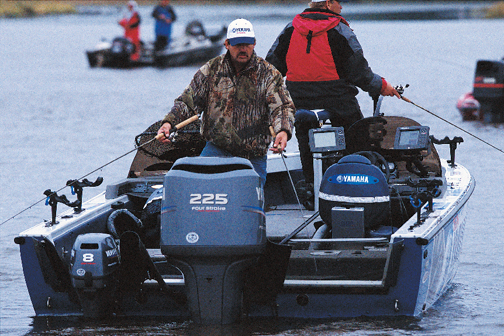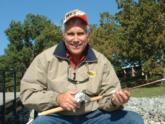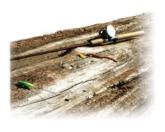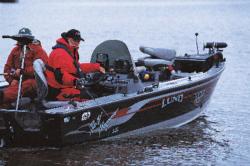Spinnin’ & winnin’

Top money-winning technique in walleye fishing revealed
In the 30-year history of walleye tournaments, one presentation has accounted for more winnings and walleyes weighed-in than any other technique. It is effective in almost all weather conditions, can be fished in lakes, rivers and reservoirs from prespawn till freeze-up, and is inexpensive and easy to rig and fish.
In-line spinner rigs tipped with either live bait or plastic can put walleyes (and lots of them) in your boat, even if you’re a novice angler. Not only do spinners present a large visual target for a walleye, they also emit sound as the blade churns through the water. Listen up, and you’ll be spinning circles around other walleye anglers in no time flat.
Let’s break down the basics of this method and review some tips learned from top walleye pros who have scored big paydays on the spinner bite. The variations to this technique are almost infinite, but don’t let that scare you. You are about to discover some basic rules that will make spinner fishing easy, even if you are a novice walleye angler.
Bait-casting gear is preferred over spinning tackle by the overwhelming number of pros when trolling spinners. Try a 6-foot, 6-inch medium-action rod and casting reel spooled with 8- to 12-pound-test monofilament line. No-stretch “super lines” are also an option; however, you may want to soften up your rod action to medium light to cushion the strike.
Weights:
The next element to consider is the weight delivery system to position the spinner in the “strike zone.” A bottom bouncer (an L-shaped wire with a weight) is the most popular choice with this presentation. Try matching the weight to the targeted depth. For instance, a 1/2-ounce bottom bouncer is usually adequate for depths down to 10 feet. Add 1/2 ounce of weight for each additional 5 feet of depth. Midsummer flats fish in 25 to 30 feet will require 2 1/2 to 3 ounces of weight. Other weight options include three-way rigging with a bell sinker on a drop line and in-line weights when fishing spinners off of planer boards.
Spinners:
Next comes the business end of this presentation: the spinner. This is where the options really expand and will require some creativity on your end. Colorado blades (the rounder shaped ones) are most commonly used because they tend to rotate well at slower speeds. Sizes three, four and five blades are usually the pros’ choice. A quick-change clevis is recommended to hold your spinner blade. It will allow you to formulate patterns and make quick adjustments.
Let the fish dictate the preferred color pattern for the conditions. Spinner blade patterns that mimic forage minnows in the system are a good place to start. There are several choices of quality pre-tied rigs available at most tackle shops.
Be sure to pay close attention to leader length. It is a key element of this presentation.
 In clear water it is often critical to distance the spinner from the weight. A 5- to 6-foot drop back from the weight to the spinner is common, and in extreme clear-water conditions, a 10-foot leader (or even longer) may be required for best results.
In clear water it is often critical to distance the spinner from the weight. A 5- to 6-foot drop back from the weight to the spinner is common, and in extreme clear-water conditions, a 10-foot leader (or even longer) may be required for best results.
Hooks are also important. If you are tying your own rigs, use premium super-sharp hooks to improve your catch percentage. Light-wire hooks are often easier to conceal in bait, and they tend to follow the spinner in a more natural fashion.
Bait:
Now we’re down to the great bait debate. When it comes to live bait, a night crawler is the preferred choice. Leeches and minnows are also good choices depending on the body of water and time of year. Keep live bait fresh and conceal the hooks for best results. When hooking a night crawler, thread the hook through the head (the dark end of the worm) and bring it out a half-inch or so down. Place the second hook in the area of the collar (the light-colored band just down from the head), squeezing the worm over the hook shank to conceal it inside the body of the crawler.
Plastic bait, like Berkley Power Crawlers, can also be a good choice, especially if you are dealing with a lot of nuisance strikes from nontargeted species, or better yet, with aggressive walleyes. Hook a plastic worm in the same fashion as a live one.
Whether trolling or drift fishing, speed is the final critical factor in this technique. When forward trolling, vary your speed between 3/4 and 1 1/2 mph, letting the fish dictate their preferred speed. If you have the proper weight on for the depth, your line should form a 45-degree angle off the tip of your rod. Try slowly pumping the rod to trigger strikes, pulling it forward 3 to 4 feet before dropping it back slowly. Oftentimes dropping the line back will tease a fish into grabbing the bait. When a walleye strikes, use a sweeping hook set for best results.
Drift fishing with spinners works well for walleyes scattered on expansive flats. Trolling spinners is very effective on underwater weed edges in natural lakes, along channel breaks or wing dams in rivers, and on sunken shorelines in reservoirs. It’s a fast-track presentation that allows you to cover water efficiently and oftentimes will engender reflex strikes from neutral walleye.
Those are the key components for catching big walleyes and lots of them. Try spinner fishing the next time you hit your favorite walleye water, and remember, spinners are winners.

